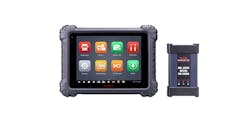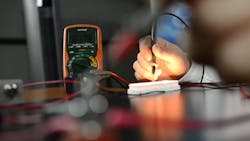The battery is the heart of every vehicle’s electrical system, and usually the first place to investigate any power issues. While some problems are visually apparent, such as corroded leads, others, such as low system voltage, aren’t as easily diagnosed without specific tools.
“Low-battery voltage could lead you down a rabbit hole, and you could be chasing the right solution for days at a time. It could cause you to misdiagnose vehicles and lead to higher repair costs in the long run,” said Chris Freeman, director of heavy-duty sales and training at Autel. He added technicians could also invest many hours following the wrong trail when the right one was merely a bad connection.
Freeman explained that low voltage could load a code for a sensor or section of the vehicle. “That could lead a technician to troubleshoot that particular system rather than diagnosing the original problem, which is low-battery voltage altogether,” Freeman said, adding that the Autel MS909CV can manage battery voltage throughout the entire vehicle.
It’s also important to note that the number of sensors and electronic connectivity points on vehicles has increased. “At this point, everything on the vehicle has an electrical control,” said Brandon Alexander, marketing manager for Thinkcar. “Newer vehicles have up to 350 sensors. That is a lot of data.”
Talon Thomas, product management technical engineer for Noregon Systems, said battery and electrical system analysis has become as important of a skill as any other in the shop. “As vehicles themselves become entirely electric, all forms of a vehicle’s electrical architecture will no doubt become more complex and tightly integrated,” he said. “All of this means that technicians will need to use all the tools available in their physical and mental toolboxes to professionally diagnose the evermore interconnected electrical problems that vehicles will face.”
Everything from advanced driver assistance systems to tire pressure monitoring systems draw on the battery. “Some people break out electrical systems like your ADAS module, cab system module, or other modules, but they all have the battery in common,” Freeman said. “Our system will give you not only the health status of the battery, but also the health status of the entire battery system. You can test and determine which battery is bad.”
See also: Gremlins and ghosts: How to combat electrical issues on modern trucks
Alexander said one of the most significant challenges is how the electrical systems react to each other. “Everything seems as if it is all interconnected between the powertrain and ADAS, SAS, and ABS. They all interface, they’re always communicating, and there are independent reactions,” he said.
One module’s reaction is based on data input from another module. “All these different modules are communicating through the CAN [bus]. The speed of it is becoming more and more critical,” Alexander said, adding that Thinkcar’s platinum series tool can diagnose a variety of issues.
Improper battery voltage can cause connectivity issues, false codes, or bad readings. “The battery needs to be the first thing you check any time you’re diagnosing a vehicle,” Autel’s Freeman said, adding that the battery must be fully charged for an accurate analysis. “Once you’ve established that static battery charge, then you can do your testing.”
Diagnostics tools are increasing visibility. “It is comparable to an operating system of a computer. The diagnostic tools allow you to physically see what is within the vehicle,” Alexander said.
Thinkcar’s tools include a topological graph that looks like an organizational chart of what is in the vehicle. “It is much easier to diagnose an issue when you have a visual representation of where everything is,” Alexander said. “A diagnostic tool, if it is used properly with the right technician, can be used to solve a whole myriad of issues.”
Thomas said electrical system analysis can be a difficult task for technicians due to the sheer number of ways electrical components can fail. “When diagnosing and repairing electrical systems, technicians must ensure they are correcting the cause and not just the symptom,” he said. “We help combat this issue in JPRO by prominently displaying battery voltage as a key data point and offer technicians the tools to locate and isolate the cause of the issue.”
Additionally, electrical problems have the highest probability of causing intermittent issues where a fault switches between active and inactive. “Consider a light bulb in your home that is flickering because of a wiring issue—off and on, over and over until the issue is corrected,” Thomas said. “This is what technicians deal with and can often be faced with faults that have a high count because, like a flickering light bulb, the fault is going in and out of an active state.”
Bruno Gattamorta, vice president of sales and marketing for Cojali USA Inc., said sensors have different power sources, and there are two primary ways they get fed power, either directly from the battery or through the KL15 and KL30.
Cojali’s tool can provide a picture of when the code is picked up and provide component information as well as operating range, pressure, and additional information. “That gives you an understanding of what the component looks like. We will also give you the process to swap the component out or repair it,” Gattamorta said.
Cojali’s tool also offers two types of wiring diagrams—the full vehicle wiring diagram and the system wiring diagram, which shows the component and the electronics. “Without the wiring diagram, you’re lost. It is a lot of guesswork, and you can’t do it,” Gattamorta said. “We’re giving you the information when you need it with the wiring diagram.”
Thomas said that Noregon has noticed a significant increase in faults related to ADAS. “These systems are heavily reliant on sensors and electronics, meaning an electrical issue can directly influence the safety of a truck, its driver, and others on the road,” he explained.
Many electrical issues don’t trigger a dash lamp, though, meaning the driver or technician has no indication that there may be an active issue that deserves attention.
“As vehicles become more connected and increase their reliance on sensors and electronics to safely operate, remote diagnostics become much more important,” Thomas said. “Without a dash lamp illuminated, remote diagnostics are the first line of defense to notice these issues early—or even pick up on intermittent issues and have their maintenance professionals decide when to down the truck for repairs.”
Not only do diagnostic tools help by providing real-time key data points like voltage readings and bidirectional tests for isolating the issue, but they also offer technicians guided diagnostics and troubleshooting assistance. “For example, JPRO’s Fault Guidance feature walks users down the ideal troubleshooting steps to locate the root cause of a problem, removing much of the guesswork, especially for less experienced technicians,” Thomas said.
Fleets can maximize uptime when issues are caught early and not allowed to fester. “A proactive maintenance approach will yield better uptime results than a reactive one, so it’s important to use the tools at your disposal to always know the health status of your trucks and to perform thorough diagnosis whenever possible to avoid foreseeable issues,” Thomas said.
Time is money, and for technicians it is all about return on investment. Freeman said diagnostic tools save time and can bring customers back. “It walks you step by step and even shows you where the batteries are located,” Freeman said, adding that Autel’s MX909CV also has a digital multimeter. “Technicians don’t have to run back to their toolbox to grab a multimeter.”
It is critical that diagnostic providers keep their technology current. Alexander said providers must stay in contact with original equipment manufacturers so they can update software regularly. “Vehicle manufacturers will frequently release new updates and patches,” he said, adding that Thinkcar recommends users update software every 30 days. “It gets technicians in the habit of doing it, and the more frequently you do it, the faster it is.”
With the exception of some very routine elements, it is nearly impossible for technicians to work on modern vehicles without a diagnostic tool, Alexander said. “From our side of it, we really see a diagnostic tool to be imperative to check on the vehicle vitals. Without that, it is kind of like going to the doctor and the doctor not having a stethoscope,” he explained.


